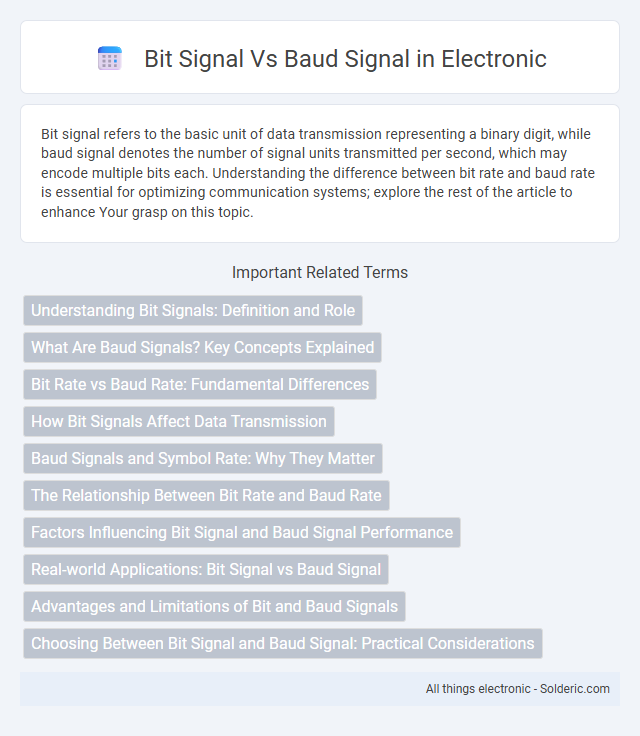Bit signal refers to the basic unit of data transmission representing a binary digit, while baud signal denotes the number of signal units transmitted per second, which may encode multiple bits each. Understanding the difference between bit rate and baud rate is essential for optimizing communication systems; explore the rest of the article to enhance Your grasp on this topic.
Comparison Table
| Feature | Bit Signal | Baud Signal |
|---|---|---|
| Definition | Represents digital data as bits per second (bps). | Represents signal changes or symbols per second. |
| Unit | Bits per second (bps) | Baud (symbols per second) |
| Measurement | Data rate (number of bits transmitted per second) | Signal rate (number of signal units or symbols transmitted per second) |
| Data Encoding | One bit equals one signal change in simple systems. | One baud may encode multiple bits using advanced modulation. |
| Relation | Bit rate can be greater than or equal to baud rate. | Baud rate <= bit rate; equals bit rate only if 1 bit per symbol. |
| Example | 1000 bps = 1000 bits transmitted per second | 1000 baud could carry 2000 bps if 2 bits per symbol used |
| Application | Used in defining raw data throughput. | Used in modulation and signal processing contexts. |
Understanding Bit Signals: Definition and Role
Bit signals represent the smallest unit of data in digital communication, typically a binary value of 0 or 1, crucial for encoding information. Each bit conveys a discrete piece of information transmitted over communication channels, forming the foundation for digital data exchange. The role of bit signals is fundamental in defining the data rate, directly impacting the efficiency and accuracy of information transfer in digital systems.
What Are Baud Signals? Key Concepts Explained
Baud signals refer to the rate at which signal changes or symbols are transmitted per second in a communication channel, measured in baud. Each baud can represent one or multiple bits depending on the modulation technique used, such as QAM or PSK, which encode multiple bits per symbol. Understanding baud rate is crucial for assessing bandwidth efficiency and link speed in digital communication systems.
Bit Rate vs Baud Rate: Fundamental Differences
Bit rate measures the number of bits transmitted per second, representing the actual data rate, while baud rate counts the number of signal changes or symbols transmitted per second. In digital communication, each symbol can encode multiple bits, making bit rate potentially higher than baud rate. Understanding the distinction is crucial for designing efficient modulation schemes and optimizing data transmission performance.
How Bit Signals Affect Data Transmission
Bit signals directly influence data transmission by determining the actual amount of information sent per second, measured in bits per second (bps). While baud rate measures the number of signal changes or symbols per second, each signal can represent multiple bits, making bit rate a more precise indicator of data transmission speed. Understanding how bit signals affect your data transmission is crucial for optimizing network performance and ensuring efficient communication.
Baud Signals and Symbol Rate: Why They Matter
Baud signals represent the number of signal changes or symbols transmitted per second, which directly determines the symbol rate of a communication channel. Understanding the baud rate is crucial because it impacts how efficiently data can be encoded and transmitted, especially when multiple bits are encoded per symbol. Your data transmission speed depends on both the baud rate and the number of bits per symbol, making baud signals a key factor in optimizing communication systems.
The Relationship Between Bit Rate and Baud Rate
The bit rate represents the number of bits transmitted per second, while the baud rate indicates the number of signal changes or symbols transmitted per second. Each symbol can encode one or multiple bits, meaning the bit rate may be equal to or greater than the baud rate depending on the modulation scheme. Advanced modulation techniques like QAM (Quadrature Amplitude Modulation) increase bits per symbol, allowing higher bit rates without increasing the baud rate.
Factors Influencing Bit Signal and Baud Signal Performance
Bit signal performance depends on factors such as signal-to-noise ratio, bandwidth, and error rate, which directly impact data transmission accuracy and speed. Baud signal performance is influenced by modulation techniques, symbol rate, and channel conditions, affecting how efficiently the signal conveys multiple bits per symbol. Optimizing these parameters enhances overall communication system reliability and data throughput.
Real-world Applications: Bit Signal vs Baud Signal
Bit signals represent the number of binary digits transmitted per second, crucial for data rate calculations in digital communications such as Ethernet and USB standards. Baud signals denote the number of signal changes or symbols transmitted per second, which is essential in modulation schemes like QAM and PSK used in DSL and cellular networks to optimize bandwidth. Real-world applications depend on the distinction between bits and baud to increase data throughput while maintaining signal integrity in advanced telecommunication systems.
Advantages and Limitations of Bit and Baud Signals
Bit signals offer precise representation of data as individual binary values, enabling accurate digital communication and efficient error detection. Baud signals represent symbol changes per second, allowing faster transmission by encoding multiple bits per symbol but may introduce complexity in modulation and higher susceptibility to noise. While bit signals prioritize clarity and simplicity, baud signals excel in bandwidth utilization but require more advanced decoding techniques to manage potential signal distortion.
Choosing Between Bit Signal and Baud Signal: Practical Considerations
When choosing between bit signal and baud signal, consider the data transmission efficiency and channel capacity requirements. Bit signal represents the number of bits transmitted per second, while baud signal measures the number of signal changes or symbols per second, impacting modulation methods and error rates. Your decision should align with system design constraints, including bandwidth availability and noise tolerance, to optimize communication performance.
bit signal vs baud signal Infographic

 solderic.com
solderic.com